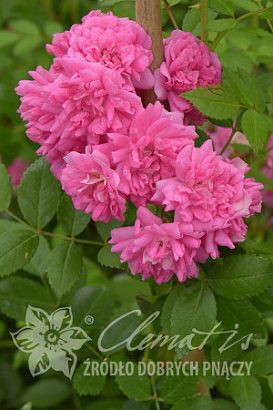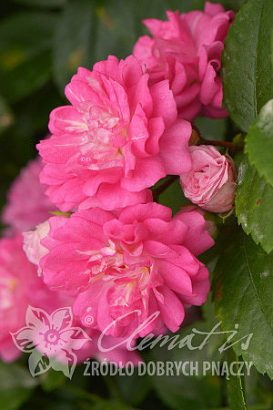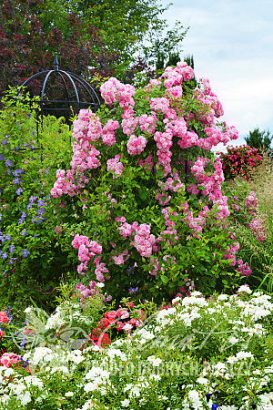Rosa SUPER DOROTHY ‘Heldoro’
Climbing rose SUPER DOROTHY 'Heldoro'| Decoration form | flowers |
|---|---|
| Color of flowers | bright pink |
| Plants height | 2 m |
| Flowering month | VI, VII, VIII, IX, X |
| Annual growth | 1-2 m |
| Aspect | sun, 3/4 sun, 1/2 sun |
| Frost hardiness | Zones 6 - 8 |
A climbing cultivar of supple shoots and double, bright pink flowers gathered in large inflorescences. Bloom abundantly over a long period of time – till autumn. It is undemanding and mildew resistant.
WHAT IT LOOKS LIKE: Flowers double, delicately scented, purple, ca. 4 cm across, tightly gathered by dozens in panicles. Appear relatively late but keep opening in a number of cycles till autumn. Leaves small, light green, leathery, slightly glossy. Shoots thin and supple.
HOW IT GROWS: A primitive climber – does not climb over supports but leans on them. Unsupported, shoots trails over ground. The height of the plant depends mainly on the support size. Fast-growing, in Poland reaches 2 m. The support needs to be large and solid.
WHERE TO PLANT: Grows well in any type of soil, however it does not tolerate compacted and heavy or very sandy and dry soil. Thrives in light, moderately permeable ground of slightly acidic or neutral pH. Requires a sunny site. Plants grown from their own roots do not cause problems with the rootstock shoots. Fully frost hardy (zone 6).
HOW TO PLANT AND MAINTAIN: Before planting immerse the plant container in water for 10-30 min. Place the root ball in a 40 x 40 x 40 cm hole with a 10 cm layer of well-rotten manure or compost, 0.5-1 cm deeper than it was before. Fill the hole with fertile soil. Does not require regular pruning. To maintain the shrub’s habit, shoots need to be tied to supports.
HOW TO APPLY: Climbing roses are often planted along supports, walls, gates, fence poles. The cultivar is recommended for parks and garden, in areas designed both in formal (e.g. by the entrance) and natural style. Suitable for private gardens as well as for public spaces. May be planted along trellises, gates, walls and fences as well as by pergolas and arbours. It’s flexible and easily follows the support’s shape.
ORIGIN: Raised by W. Hetzel, Germany, 1986.








